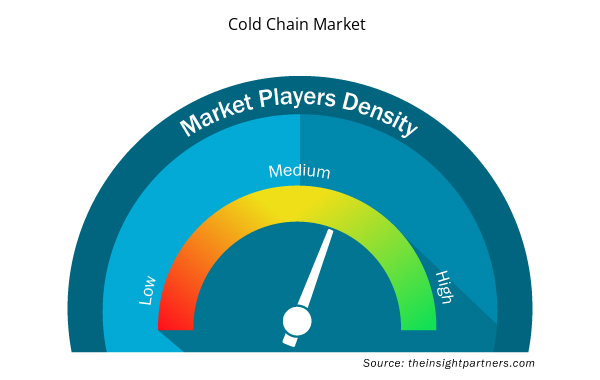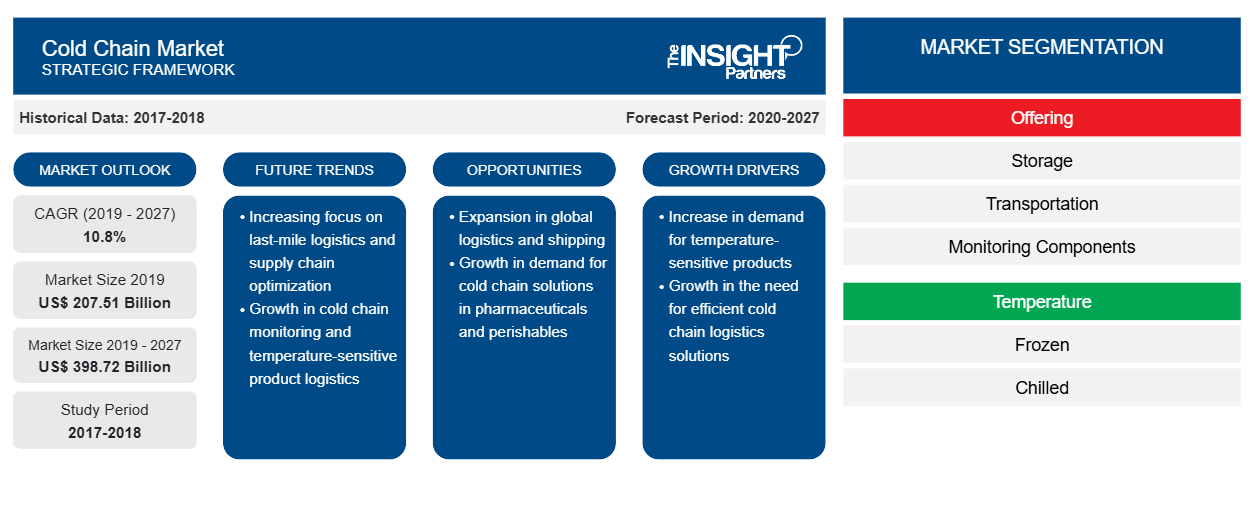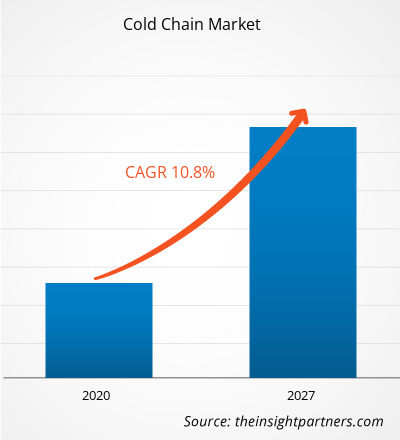从收入方面来看,2019 年冷链市场价值为 2075.108 亿美元,预计到 2027 年将达到 3987.234 亿美元,预计预测期内复合年增长率为 10.8%。
易腐产品贸易的增加和政府对冷链基础设施发展的积极支持是推动冷链市场增长的关键因素。冷链服务参与者也在采用先进技术来满足日益增长的食品安全需求,特别是加工食品。预计这将提供大量机会,从而推动多家跨国供应商进入市场,旨在提供高效的冷链解决方案。
此外,严格的食品安全法规(如《食品安全现代化法案》)预计将支持市场的增长,该法案要求更加重视建立冷藏仓库。然而,预计在预测期内,温室气体排放等环境问题将阻碍市场的发展。
亚太地区是冷链市场的第二大地区。由于政府对物流基础设施开发和仓库管理系统 (WMS) 部署的投资不断增加,预计该地区在预测期内将出现显著增长。中国是该地区的主要贡献者,预计在预测期内将出现相当大的复合年增长率。包装、加工和食品储存技术的进步预计将推动冷链市场的增长。此外,冷链基础设施需求和发展的快速增长使中国成为一个关键市场。目前,中国正在经历从制造业主导型经济向消费主导型经济的快速转变。
定制此报告以满足您的需求
您可以免费定制任何报告,包括本报告的部分内容、国家级分析、Excel 数据包,以及为初创企业和大学提供优惠和折扣
- 获取此报告的关键市场趋势。这个免费样品将包括数据分析,从市场趋势到估计和预测。
新冠疫情对冷链市场的影响
2019 年 12 月始于中国武汉的 COVID-19 疫情已迅速蔓延至全球。为抗击和控制疫情,全球工厂停工、旅行禁令和边境封锁已影响到全球各行各业和经济。大多数制造工厂要么暂时关闭,要么以最低限度的人员运营;因此,冷链和相关部件中断。此外,自 COVID-19 在各国爆发以来,对冷冻食品的需求一直在放缓。
市场洞察
增加亚太地区杂货的全渠道分销
亚洲不断增长的人口对来自国内外的优质食品供应产生了强烈的需求。2017 年至 2019 年,亚太地区进口的有机浆果产品(包括草莓和黑莓)的复合年增长率为 7.5%。全渠道分销的发展促进了消费的增长。网上食品购物仍处于早期阶段,2019 年,大多数亚太市场的主要食品支出中只有不到 5% 是在网上进行的。这一比例预计会增加快速配送,尤其是在韩国和中国。目前,主要的在线主要食品配送网站,例如中国的京东和苏宁易购以及印度的 Big Basket,目前已在顶级城市提供当日或 24 小时内送达服务。
基于产品的洞察
在供应方面,仓储部门在 2019 年占据了全球冷链市场的主导份额。冷冻食品和饮料、化学品、药品以及用于制造上述产品的原材料应在保存条件下储存以保持质量。应遵循制造商关于储存温度的建议,这涉及使用专门的储存设施。应使用温度监测设备来证明符合首选温度范围。良好的仓储实践包括根据制造商的建议为温度敏感产品维持最佳温度。应按规定的时间间隔校准和测试测量和监测设备。这些产品的运输方式应使其不会受到不可接受的冷热程度的影响,并在必要时使用专门的运输方式。
基于温度的洞察
一般来说,冷冻货物是指需要在最佳温度下运输和储存的商品或食品,以防止腐烂和致病生物的生长。特定的冷冻货物需要在低于 -20°C (-4°F) 的温度下运输或储存,以保持质量、质地和风味。冰淇淋和鱼糜等脂肪含量高的商品应在 -26.1°C (-15°F) 或更低的温度下运输和储存。低温可以保持冷冻食品的质量、香气、风味、质地和外观,并防止其变质。
基于垂直行业的洞察
易腐食品的冷链通常是指在价值链的收获后步骤中,在低温条件下对产品进行持续处理,包括收集、收获、加工、储存、包装、运输和营销,直到到达消费者手中。组合冷链包括管理易腐食品从牧场、田地或水体到收获后整个链条再到最终用户的运输。
在冷链市场,各公司正在采取不同的策略,包括产品开发、收购和其他扩张相关策略,以满足对其产品日益增长的需求,从而扩大其全球影响力。以下列出了冷链市场的一些最新举措:
2020 年:Americold Realty Trust 宣布计划投资约 4300 万美元,扩建位于新西兰奥克兰的 Dalgety 工厂。2020
年:AmerisourceBergen 通过整合其两家业务公司(全球物流供应商 World Courier 和第三方物流 ICS)增强了其物流服务。这创造了第一个也是唯一一个提供从临床试验到商业化的全面支持的专业物流合作伙伴。2020 年
:Pelican BioThermal 在多伦多开设了一个网络站,为其 Credo on Demand 租赁计划提供服务。新的网络站加入了该公司不断增长的全球 100 多个网络站和投递点系统。除了作为 Credo On Demand 租赁客户的投递点外,网络站还为公司的可重复使用的 Credo Cargo 以及 Credo Xtreme 运输集装箱提供服务、翻新、维修和调理,以供重复使用。
冷链市场区域洞察
Insight Partners 的分析师已详细解释了预测期内影响冷链市场的区域趋势和因素。本节还讨论了北美、欧洲、亚太地区、中东和非洲以及南美和中美洲的冷链市场细分和地理位置。

- 获取冷链市场的区域具体数据
冷链市场报告范围
| 报告属性 | 细节 |
|---|---|
| 2019 年市场规模 | 2075.1亿美元 |
| 2027 年市场规模 | 3987.2亿美元 |
| 全球复合年增长率(2019 - 2027) | 10.8% |
| 史料 | 2017-2018 |
| 预测期 | 2020-2027 |
| 涵盖的领域 | 通过奉献
|
| 覆盖地区和国家 | 北美
|
| 市场领导者和主要公司简介 |
|
冷链市场参与者密度:了解其对业务动态的影响
冷链市场正在快速增长,这得益于终端用户需求的不断增长,而这些需求又源于消费者偏好的不断变化、技术进步以及对产品优势的认识不断提高等因素。随着需求的增加,企业正在扩大其产品范围,进行创新以满足消费者的需求,并利用新兴趋势,从而进一步推动市场增长。
市场参与者密度是指在特定市场或行业内运营的企业或公司的分布情况。它表明在给定市场空间中,相对于其规模或总市场价值,有多少竞争对手(市场参与者)存在。
在冷链市场运营的主要公司有:
- 冷链技术有限公司
- CSafe全球
- DoKaSch 温度解决方案有限公司
- 环保容器公司
- 鹈鹕生物热有限公司
免责声明:上面列出的公司没有按照任何特定顺序排列。

- 了解冷链市场主要参与者概况
市场细分
冷链市场 – 按产品
- 贮存
- 运输
- 监控组件
- 硬件
- 软件
- 其他的
冷链市场 – 按温度
- 冰冻
- 冷藏
冷链市场 – 按垂直行业划分
- 制药
- 卫生保健
- 食品和饮料
- 化学
- 其他的
冷链市场-按区域
北美
- 我们
- 加拿大
- 墨西哥
欧洲
- 法国
- 德国
- 意大利
- 英国
- 俄罗斯
- 欧洲其他地区
亚太地区
- 中国
- 印度
- 韩国
- 日本
- 澳大利亚
- 亚太地区其他地区
中东和非洲
- 南非
- 沙特阿拉伯
- 阿联酋
MEA 其他地区
- 南美洲
- 巴西
- 阿根廷
- SAM 其余部分
冷链市场公司简介如下:
- 冷链技术有限公司
- CSafe全球
- DoKaSch 温度解决方案有限公司
- 环保容器公司
- 鹈鹕生物热有限公司
- SKYCELL 公司
- Softbox 系统有限公司
- Sonoco ThermoSafe
- va-Q-tec AG
- 世界速递
- 历史分析(2 年)、基准年、预测(7 年)及复合年增长率
- PEST 和 SWOT 分析
- 市场规模价值/数量 - 全球、区域、国家
- 行业和竞争格局
- Excel 数据集


- Collagen Peptides Market
- Airport Runway FOD Detection Systems Market
- Wheat Protein Market
- Fertilizer Additives Market
- Pressure Vessel Composite Materials Market
- Personality Assessment Solution Market
- Hair Extensions Market
- Nuclear Waste Management System Market
- Integrated Platform Management System Market
- Aircraft Landing Gear Market

Report Coverage
Revenue forecast, Company Analysis, Industry landscape, Growth factors, and Trends

Segment Covered
This text is related
to segments covered.

Regional Scope
North America, Europe, Asia Pacific, Middle East & Africa, South & Central America

Country Scope
This text is related
to country scope.
常见问题
Frozen food and beverages, chemicals, and medicinal products, and starting materials used in the manufacture of the above products, should be stored under conditions that ensure that their quality is maintained. Manufacturers’ recommendations concerning storage temperatures should be observed, and this may involve the use of specialized storage facilities. Temperature-monitoring devices should be used to exhibit compliance with the preferred temperature ranges. Good warehousing practices require that storage areas for temperature-sensitive products should be maintained within acceptable temperature limits and that, where the manufacturer specifies special storage conditions, they should be provided, checked, and monitored. Measuring and monitoring equipment should be calibrated and tested at defined intervals. These products should be transported in such a way that they are not subjected to unacceptable degrees of heat and cold, and specialized means of transportation should be used where necessary.
The North America region led the cold chain market in 2019. The US signifies one of the world’s largest temperature-sensitive healthcare products market. Transportation of temperature-sensitive healthcare products such as biopharmaceuticals, vaccines, as well as clinical trial materials, occupies a huge share in the US cold chain market. In addition, the developed healthcare sector has led to automation for products, thereby removing the possibility of human handling errors in the cold chain. In addition to this, several cold chain logistics, as well as transportation providers such as AmerisourceBergen and FedEx, have accelerated their market growth in the region. Rapid innovations in technology and growing consumer awareness for healthcare cold chain products are expected to spur the market demand during the forecast period.
Asia's developing common populace is creating compelling interest for excellent food supplies sourced from home and abroad. Imports of organic berry products, including strawberries and blackberries to the Asia Pacific, recorded a CAGR of 7.5% from 2017to 2019.The development of Omni channel dispersion is encouraging developing utilization. In any case, online shopping for food is still at an early stage, with under 5% of essential food item spending in most Asia Pacific markets happening on the web in 2019. This proportion is relied upon to increment of quick delivery speed, particularly in Korea and China. Major online primary food delivery websites, such as JD.com and Suning.com in China, Big Basket in India presently offer that day or under 24-hour conveyance in top-level urban communities.
Trends and growth analysis reports related to Automotive and Transportation : READ MORE..
The List of Companies - Cold Chain Market
- Cold Chain Technologies, Inc.
- CSafe Global
- DoKaSch TEMPERATURE SOLUTIONS GmbH
- Envirotainer AB
- Pelican BioThermal LLC
- SKYCELL AG
- Softbox Systems Ltd.
- Sonoco ThermoSafe
- va-Q-tec AG
- World Courier
The Insight Partners performs research in 4 major stages: Data Collection & Secondary Research, Primary Research, Data Analysis and Data Triangulation & Final Review.
- Data Collection and Secondary Research:
As a market research and consulting firm operating from a decade, we have published and advised several client across the globe. First step for any study will start with an assessment of currently available data and insights from existing reports. Further, historical and current market information is collected from Investor Presentations, Annual Reports, SEC Filings, etc., and other information related to company’s performance and market positioning are gathered from Paid Databases (Factiva, Hoovers, and Reuters) and various other publications available in public domain.
Several associations trade associates, technical forums, institutes, societies and organization are accessed to gain technical as well as market related insights through their publications such as research papers, blogs and press releases related to the studies are referred to get cues about the market. Further, white papers, journals, magazines, and other news articles published in last 3 years are scrutinized and analyzed to understand the current market trends.
- Primary Research:
The primarily interview analysis comprise of data obtained from industry participants interview and answers to survey questions gathered by in-house primary team.
For primary research, interviews are conducted with industry experts/CEOs/Marketing Managers/VPs/Subject Matter Experts from both demand and supply side to get a 360-degree view of the market. The primary team conducts several interviews based on the complexity of the markets to understand the various market trends and dynamics which makes research more credible and precise.
A typical research interview fulfils the following functions:
- Provides first-hand information on the market size, market trends, growth trends, competitive landscape, and outlook
- Validates and strengthens in-house secondary research findings
- Develops the analysis team’s expertise and market understanding
Primary research involves email interactions and telephone interviews for each market, category, segment, and sub-segment across geographies. The participants who typically take part in such a process include, but are not limited to:
- Industry participants: VPs, business development managers, market intelligence managers and national sales managers
- Outside experts: Valuation experts, research analysts and key opinion leaders specializing in the electronics and semiconductor industry.
Below is the breakup of our primary respondents by company, designation, and region:

Once we receive the confirmation from primary research sources or primary respondents, we finalize the base year market estimation and forecast the data as per the macroeconomic and microeconomic factors assessed during data collection.
- Data Analysis:
Once data is validated through both secondary as well as primary respondents, we finalize the market estimations by hypothesis formulation and factor analysis at regional and country level.
- Macro-Economic Factor Analysis:
We analyse macroeconomic indicators such the gross domestic product (GDP), increase in the demand for goods and services across industries, technological advancement, regional economic growth, governmental policies, the influence of COVID-19, PEST analysis, and other aspects. This analysis aids in setting benchmarks for various nations/regions and approximating market splits. Additionally, the general trend of the aforementioned components aid in determining the market's development possibilities.
- Country Level Data:
Various factors that are especially aligned to the country are taken into account to determine the market size for a certain area and country, including the presence of vendors, such as headquarters and offices, the country's GDP, demand patterns, and industry growth. To comprehend the market dynamics for the nation, a number of growth variables, inhibitors, application areas, and current market trends are researched. The aforementioned elements aid in determining the country's overall market's growth potential.
- Company Profile:
The “Table of Contents” is formulated by listing and analyzing more than 25 - 30 companies operating in the market ecosystem across geographies. However, we profile only 10 companies as a standard practice in our syndicate reports. These 10 companies comprise leading, emerging, and regional players. Nonetheless, our analysis is not restricted to the 10 listed companies, we also analyze other companies present in the market to develop a holistic view and understand the prevailing trends. The “Company Profiles” section in the report covers key facts, business description, products & services, financial information, SWOT analysis, and key developments. The financial information presented is extracted from the annual reports and official documents of the publicly listed companies. Upon collecting the information for the sections of respective companies, we verify them via various primary sources and then compile the data in respective company profiles. The company level information helps us in deriving the base number as well as in forecasting the market size.
- Developing Base Number:
Aggregation of sales statistics (2020-2022) and macro-economic factor, and other secondary and primary research insights are utilized to arrive at base number and related market shares for 2022. The data gaps are identified in this step and relevant market data is analyzed, collected from paid primary interviews or databases. On finalizing the base year market size, forecasts are developed on the basis of macro-economic, industry and market growth factors and company level analysis.
- Data Triangulation and Final Review:
The market findings and base year market size calculations are validated from supply as well as demand side. Demand side validations are based on macro-economic factor analysis and benchmarks for respective regions and countries. In case of supply side validations, revenues of major companies are estimated (in case not available) based on industry benchmark, approximate number of employees, product portfolio, and primary interviews revenues are gathered. Further revenue from target product/service segment is assessed to avoid overshooting of market statistics. In case of heavy deviations between supply and demand side values, all thes steps are repeated to achieve synchronization.
We follow an iterative model, wherein we share our research findings with Subject Matter Experts (SME’s) and Key Opinion Leaders (KOLs) until consensus view of the market is not formulated – this model negates any drastic deviation in the opinions of experts. Only validated and universally acceptable research findings are quoted in our reports.
We have important check points that we use to validate our research findings – which we call – data triangulation, where we validate the information, we generate from secondary sources with primary interviews and then we re-validate with our internal data bases and Subject matter experts. This comprehensive model enables us to deliver high quality, reliable data in shortest possible time.


 获取此报告的免费样本
获取此报告的免费样本